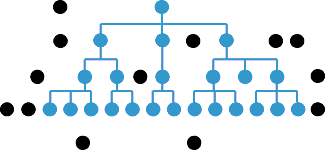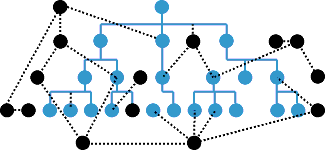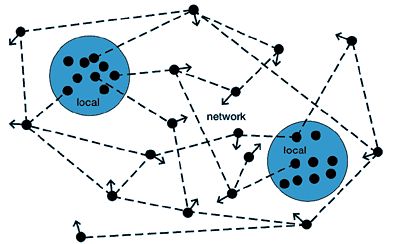Network church
Published in Movement magazine issues 116 & 117 April & September 2004
If there's one single thing that characterises emerging forms of church across the western world it's that they are networked. There is no one leader or format or theology, nor is there likely to be. Instead there is a thriving mess of cross-linkage without regard for conventional church structures or channels of communication. It's the context and lifeblood of the emerging church, the arteries of the Body so to speak, and yet it's largely invisible to the existing institutional forms of church.
Partly this invisibility is down to technology-blindness, since a lot of the connection happens on the internet. More fundamentally, it's down to a prevailing model of the church as local & institutional - local groups and events, linked to others [if at all] through institutions and agencies rather than individual or group-to-group contact. So emerging church groups appear small and anomalous within their local church context, whereas from 'inside' they appear as parts of a global movement. It's like seeing the mushrooms, but not the threads below ground linking them as one organism.

This is the situation as we have it. The blue represents the institutional church, the black represents emerging church expressions of whatever form.

This is what the institutional church fondly imagines will happen. It sees the emerging forms as parish churches in embryo [or whatever the denominational building block might be]. Given time, encouragement, resourcing, they will grow the institution, even if it has to adapt to new appearances and behaviours.

This is what is actually happening. The emerging forms network across and around the institution. Some are connected into it, some are not and maybe don't want to be. Many of them will never be churches in the institutional understanding of the term, and attempts at making them so will damage or repel them. They are not so much churches as church - church as verb not noun. They may even be single individuals. What matters is not size or structure but contribution. Anything that resources the network gets the traffic - whether the resourcing body is a megachurch, a small group or an individual.

In the local/institutional model, above, the word 'church' usually means an organisational unit operating in a particular locality - whether formalised as a parish or just understood as a catchment area. If a church has subgroups [eg homegroups and committees] these are themselves localised within the catchment area of the parent church. Both subgroups and parent churches link to others outside the area through the institutions and agencies - up, across and down rather than sideways through individual or direct group-to-group contact.
This is a potent source of misunderstanding towards emerging church groups. In the local/institutional model it isn't expected that a subgroup should link directly to other subgroups in other organisations or places. So, for example, an alternative worship group attached to a parish church looks, from a local/institutional perspective, like a sort of renegade homegroup. They don't fit in, they don't join in, they seem few and isolated. Some of them aren't even members of our church. What gives them the right to critique it or do their own worship? The network connections of the group are invisible to non-members, or not understood as important by people whose working model of church is local/institutional. Some of the fears about alt worship groups being 'shadowy' or 'unaccountable' come from this partial visibility. It looks like disconnection if you can't see the reconnections. Outsiders can't 'see in' especially if they don't come to the services.
But from inside the group it's the local/institutional church that seems isolated, because it doesn't network outside its institutional structure or give and take resources from the wider network. From inside, a networked group is a space which opens into many other spaces. The people are not few but many, but they are not all in one place. In computer terms, the local/institutional model of church resembles a mainframe with terminals, in the days before PCs or the internet. The terminals draw their computing power from the centre and don't resource one another directly. The mainframe itself may not be connected to any other. Whereas the network church model resembles PCs on the internet. Computing power is distributed not centralised, and every machine connects to every other. Big problems are solved collectively not centrally.
Science fiction series such as Deep Space Nine and Farscape use the concept of the 'wormhole' - a distortion of space and time which allows you to get from A to B across the universe without having to pass through all the space and time in between. It's a useful plot device for introducing unexpected visitors from distant places. My alt worship group Grace often feels as if it's near the entrance to a wormhole [though it's probably just a Tube]. We get unexpected arrivals from anywhere. Few are immediately local, many come from considerable distances, even from across the planet. [But not, as yet, from across the galaxy. As far as we know.] It's network church in action, and rather bewildering to the local/institutional church who don't see why people would travel to something 'small' and 'marginal'.
In his book 'A Churchless Faith' Alan Jamieson found that most people who left churches retained their faith and even grew in it, in spite of or even because of their lack of conventional belonging. A lot of those who 'leave' churches are not leaving The Church [ie the Body of Christ] but are leaving the local/institutional for the network. They are moving into a wider circle of connectedness, retaining some at least of their existing connections including, often, links back into the churches they have 'left'.

This is what it looks like to those in the local/institutional church paradigm. The person that leaves is 'outside', alone, 'lost', in the trackless waste.

This is the view for those in the network church paradigm. The 'trackless waste' is full of wider connections, including back into the local/institutional churches. These appear as concentrations or nodes that are not as self-sufficient as they imagine. They are not the only places 'church' happens.

